Hayden and I have our hearts set on a sunny 99 year old bungalow that sits near a cliff leading down to the Connecticut River. It’s been empty for two years and feels like it is calling us to come repair and restore it to its former glory. Just like our place in Brooktondale, the house sits on a corner lot and there is just enough space to build a greenhouse and have a few sprawling herb, veggie, and flower gardens. Inside there is ample space for gathering as well as future sites for herb and dye studios. Currently there is a giant privet hedge wrapping around 2 sides the exterior of the house - sooo much privet. We are dreaming of taking the privet out and replacing it with native fruit and medicine shrubs to enjoy with our future neighbors. Which is why I’m writing to you! Today I’m sharing a list of my favorite medicinal shrubs for your yarden - that is, the garden of your yard.
By the way, don’t get too excited about my bungalow dreams - Hayden and I have already put in and lost two bids on properties we loved during this wild house hunt. Some may take the tact of preceding with caution so as to not get their hearts broken, but that just couldn’t be me. I allow myself to get excited and fully envision our lives in each place. It stings when we have lost bids in the past, but it’s just part of my process. We are now in the midst of bidding on this dream spot - oddly, it is a bit complicated because of its situation of being empty. I’ll let you know if we are able to move forward with it - but in the meantime, here is a list of medicinal shrubs that you can plant around your own house and garden.
Top 10 native plants to add to your yarden
10. Smooth Sumac (Rhus glabra)

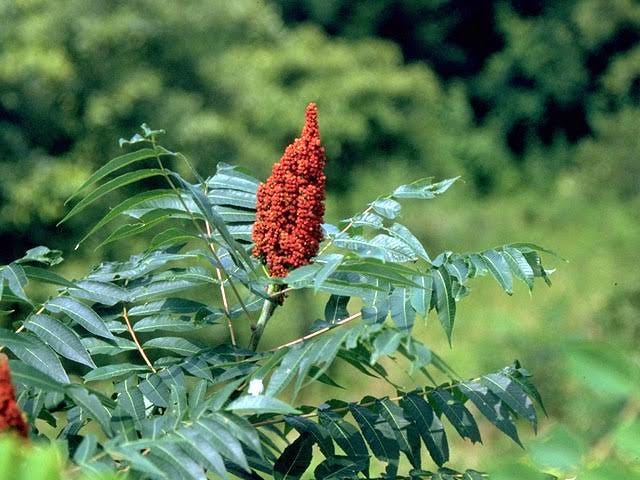
Native Range: Smooth Sumac is the only shrub or tree native to all 48 contiguous states!
Growth habit: This elegant shrub thrives in wayside places: roadsides and open fields. It is considered an early successional species and so it’s no surprise that it is often found growing in recently burned areas. It does well with sandy or gravelly soil and tolerates slightly acidic soils. Smooth Sumac requires full sun. Sumac spreads easily by forming colonies so only plant it somewhere you are comfortable with it spreading out. This is a gorgeous plant with bright green foliage that turns a crimson red in autumn.
From the USDA Natural Resources Conservation Service: Sumac serves primarily as a winter emergency food for wildlife. Ring-necked pheasant, bobwhite quail, wild turkey, and about 300 species of songbirds include sumac fruit in their diet. It is also known to be important only in the winter diets of ruffed grouse and the sharp-tailed grouse. Fox squirrels and cottontail rabbits eat the sumac bark. White-tail deer like the fruit and stems.
Medicine: You can use Smooth Sumac and it’s taller cousin Staghorn Sumac interchangeably. The berries and leaves are astringent and have many medicinal traits associated with their drying properties. The berries can be steeped in water to create a beautiful and tangy beverage that rivals pink lemonade. In fact, have you ever seen pink lemons? This drink is the original pink lemonade. The berries can also be collected, dried and added to spice blends, such as in Za’atar, which is a Palestinian spice blend made with a Sumac species that grows in the Middle East.
Dye: The leaves and bark of sumac are so rich in tannins that they can be used to pre-treat fabric before dyeing. I’m planning to work with Sumac this summer as a “plant based mordant”. On it’s own it imparts a very light yellow hue on fabric but I’m more interested in Sumac’s ability to help other more saturated plant dyes hold fast on fabric.
Plant sumac along the edge of your property in nutrient poor soils and expect a lush sumac hedge to emerge and expand.
Images from jerseyyards.org
9. Sweet Fern (Comptonia peregrina)
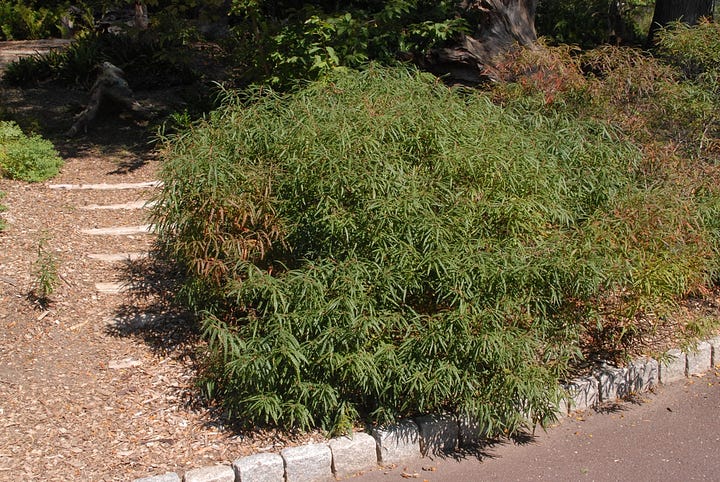

Native Range: Eastern North America
Growth Habit: Sweet Fern is not actually a fern, it is a low growing shrub with fernlike foliage. The “sweet” in the same comes from the fragrant scent given off by the leaves when rubbed or crushed. This mounded shrub is tolerant of sun conditions from full to partial and can thrive in soils that are medium wet. This is another early successional shrub and can be found growing from woodlands to grasslands.
Medicine: My first experience with Sweet Fern medicine was when I was in herb school in the mountains of North Carolina in 2017. Sweet Fern, or Comptonia as we sometimes called it, grew in hedges along the pathway up to the peak of the mountain behind the school. My teacher noticed I had a mild sunburn one day and recommended I make an infusion of sweet fern leaves and apply the cooled infusion to my sunburn with a cloth. I did and found it to be deeply soothing. I have also wrapped this plant in a bundle to burn for its cleansing smoke medicine.
Sweet Fern is a great little shrub to plug into your perennial pathways or hedge lines.
Photos from an internet search
8. Calycanthus (Calycanthus floridus)
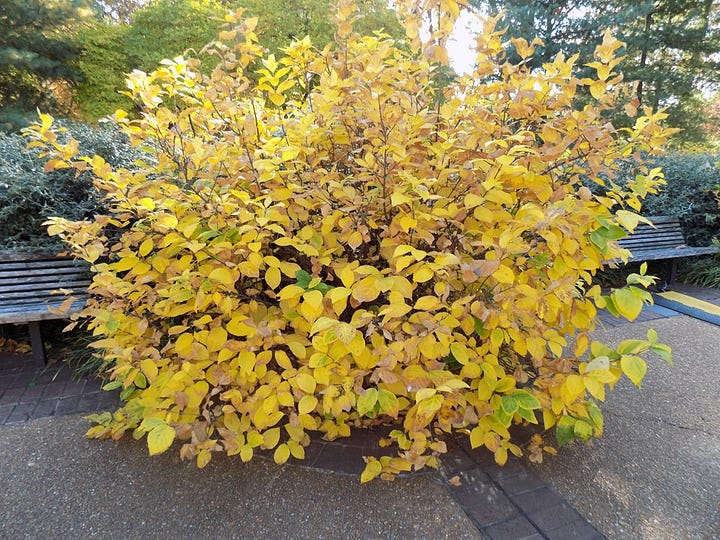
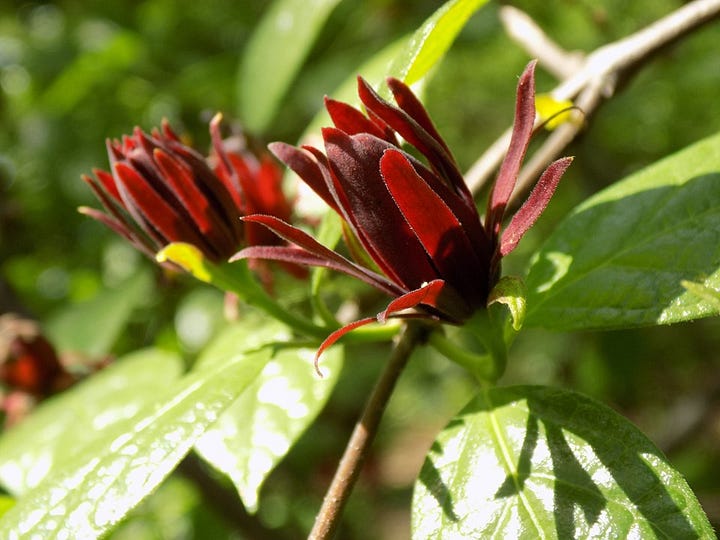
Native Range: South of New England, however it can be found growing ornamentally in Connecticut and Massachusetts. Northern neighbors should keep in mind that Calycanthus’s native range is shifting with climate change, so if you want to grow it - you should try!
Growth Habit: I have come across Calycanthus growing in the understory of woodlands in mountainous western North Carolina. It does best with partial shade and rich, well drained but moist soils. This shrub can be a show stopper on the edge of your garden, growing around 12 feet tall.
Medicine: Calycanthus is also known as Carolina All Spice, Sweet Shrub, and Sweet Bubby Bush. The flowers have a fruity sweet smell and I’ve heard southern women used to place the flowers in their bras for a natural perfume (hence the name Sweet Bubby). I’ve read that a tea made from the root or bark has a strong emetic quality but thankfully I have never had to work with Calycanthus for this property.
Are you looking to add color and interest to a shadier part of your yard? Plant Calycanthus! And be sure to experiment with it as a natural perfume…
Photos from Missouri Botanical Garden
7. Shrubby Saint John’s Wort (Hypericum prolificum)

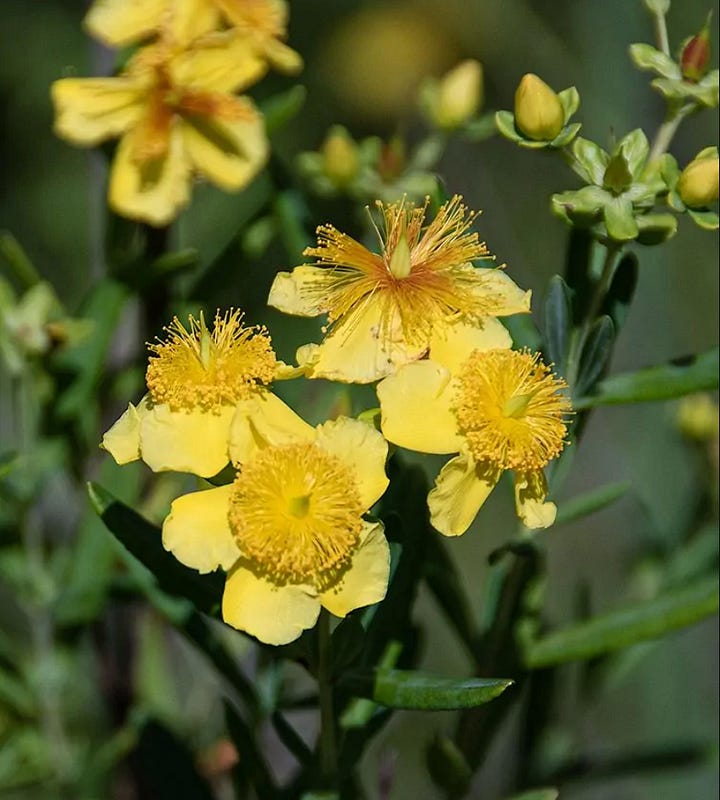
Native Range: All along the east coast of North America and westward to Minnesota and eastern Texas.
Growth Habit: Shrubby Saint John’s Wort can be found growing in meadows, farm fields, open areas in woodlands, edges of swamps, and on rocky bluffs. It is a small mounded shrub that is absolutely loaded with blooms. Hayden and I grew hundreds of Shrubby Saint John’s Wort plugs in Brooktondale and distributed to friends, families, and his clients. I love to see it establishing in my mother’s garden on a dry terraced garden slope. She says pollinators buzz around it more than any other plant in her garden.
Medicine: The Saint John’s Wort species known as Common Saint John’s Wort, Hypericum perforatum, is primarily the one used for medicine. However, Shrubby Saint John’s wort also contains hypericin, one of the major medicinal constituents in SJW. There are also reports of indigenous tribes of North America working with Shrubby Saint John’s Wort for medicine, though not in the same way that I think about common SJW being used. I need to do more experimenting with this species of SJW in the apothecary, but I don’t doubt its medicinal value.
Dye: The flowers and leaves can produce shades in the yellow and red family. I have combined Saint John’s Wort with dyer’s coreopsis, cosmos, and calendula to produce vibrant yellow oranges.
Tuck Saint John’s Wort into your gardens for a small mounded shrub that can play well with other plants in your garden.
Photos from Prairie Nursery
6. Witch Hazel (Hamamelis virginiana)
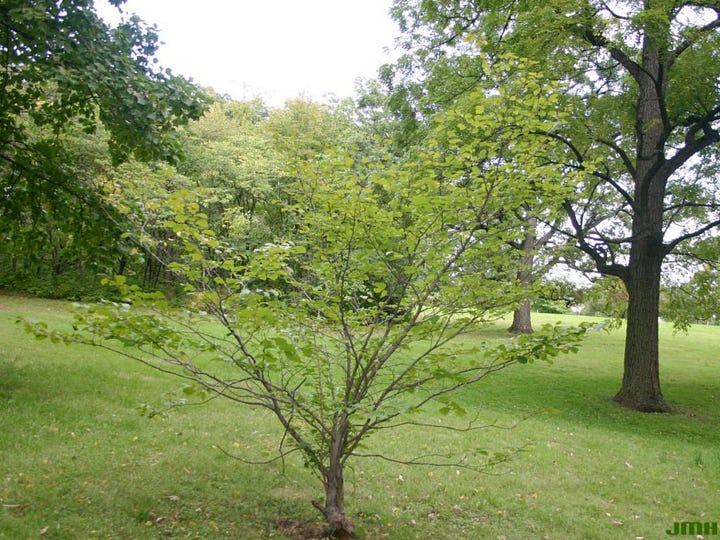
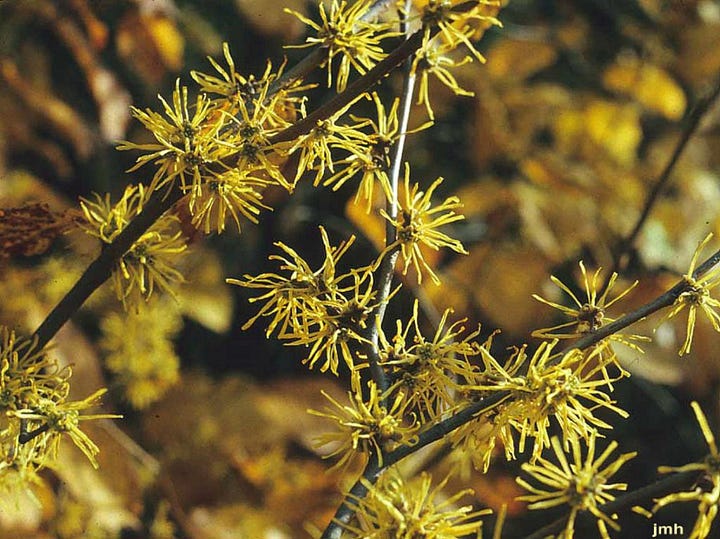
Native Range: From the USDA: “grows throughout northeast and southeast North America, from Nova Scotia to Florida and from the Great Lakes to eastern Texas.”
Growth Habit: Witch Hazel is a shrub or small tree, capable of growing 20’ tall and 20’ wide, though typically it is significantly smaller. As an understory plant, Witch Hazel prefers at least partially shady conditions and does best in rich, moist soils. Witch Hazel’s late autumn and winter blooms are so appreciated when scarcely any other blooms can be found.
Medicine: From the Modern Herbal Dispensatory by Thomas Easley: “Witch hazel is primarily used topically as an astringent. It can also be used as a suppository for hemorrhoids and anal fistula. … Properties: Anti-inflammatory, astringent, styptic and vulnerary”.
Plant Witch Hazel on the shady north side of your house so you can see the cold season blooms from your window.
Photos from Morton Arboretum
5. New Jersey Tea (Ceanothus americanus)
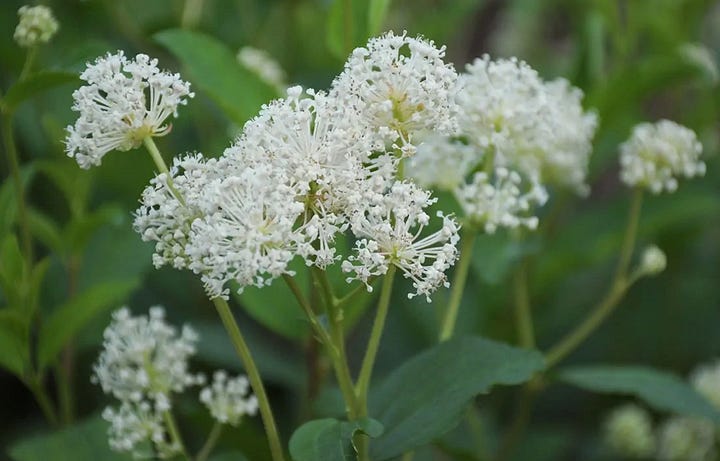

Native Range: New Jersey Tea is native to and can be found widely distributed through all of eastern North America.
Growth Habit: New Jersey Tea prefers medium to dry soil and full to partial sun. This is a small shrub, a mound of roughly 2-3 feet tall and wide with fragrant white flowers that bloom all summer.
Medicine: The name originates from colonists who used the leaves as a tea substitute (though it contains no caffeine). However, native people of North American were using the medicine of Ceanothus americanus long before that. Another commonly used name for this herb is Red Root. I have primarily worked with it in formulas to support a sluggish lymphatic system.
Plant Ceanothus in your perennial flower or herb gardens for pretty blooms that last all summer.
Photos from Prairie Nursery
4. Black Haw Viburnum (Viburnum prunifolium)
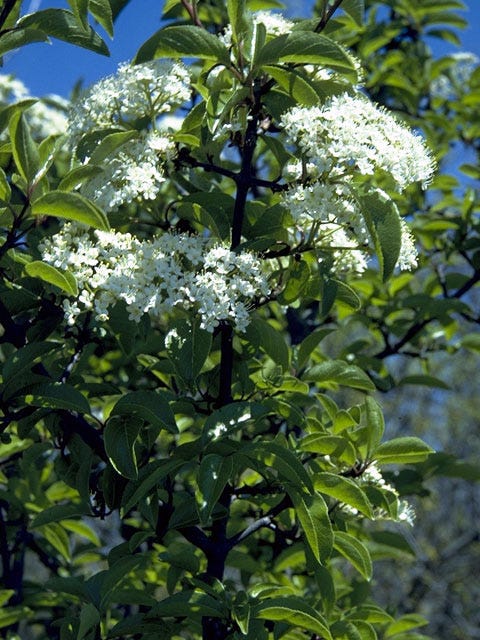
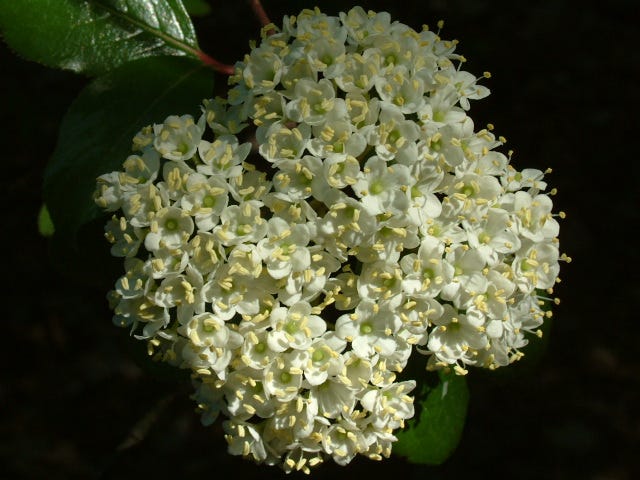
Native Range: Eastern North America westward through Texas.
Growth Habit: Black Haw is a large shrub that can make an attractive hedge or privacy screen. It does best in partial sun to light shade and prefers rich, moist soils.
Medicine: Black Haw has antispasmodic properties and a long history of use as a medicine to native tribes of North America. I have used it in formulas to relieve menstrual cramping.
Plant Black Haw If you need an understory privacy screen with added medicinal benefits.
Photos from The Lady Bird Johnson Wildflower Center
3. Swamp Rose (Rosa palustris)
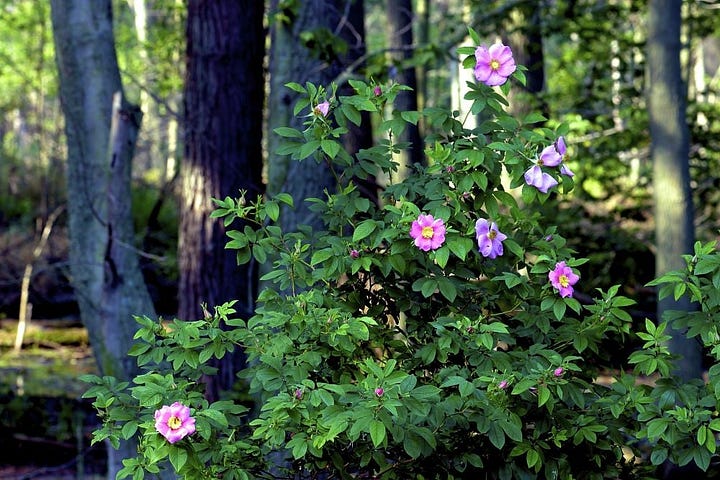

Native Range: Swamp Rose is native to all of the eastern United States.
Growth Habit: As the name suggests, Swamp Rose likes to grow in wet places. It can be found in swamps, marshes, and stream edges. It prefers slightly acidic soils and full to partial sun. This rose species can grow seven feet tall.
Medicine: Roses are edible in their flower and fruit forms. You can add petals to teas, salad, pastries and make vitamin c rich jams with the hips. Roses are energetically cooling and impart a feeling of sweetness and calm. Does that sound weird? Try a few rose petals in your next cup of Chamomile tea and you will see what I mean.
Do you have a wet area on your property with space for an elegantly sprawling rose bush? You know what to do!
Photos by Direct Native Plants
2. Spice Bush (Lindera benzoin)
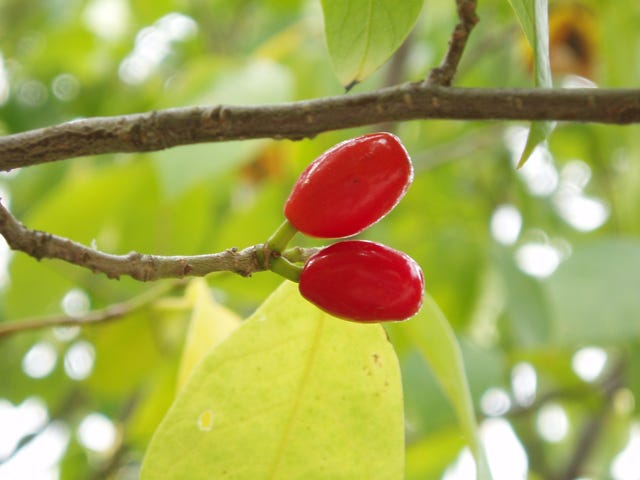
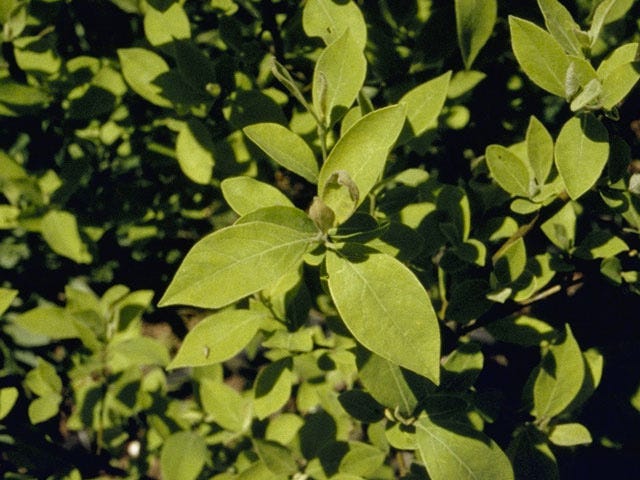
Native Range: Spice Bush is native to eastern North America and can be found growing as far west as Texas.
Growth Habit: When I worked at UPenn’s “Biopond,” a fellow gardener once told me, “If all of us humans disappeared tomorrow, Spice Bush would take over the garden.” Indeed, Spicebush can thrive in dry and moist soils as well as shady or sunny conditions. This adaptable shrub has populated the woodlands of all the places I’ve lived: Pennsylavnia, North Carolina, New York, and Connecticut. In Spring, the cheerful yellow flowers are among the first to bloom in the forest. When I walk by this shrub in spring and summer, I always gently rub a leaf to take in the fragrance, which is a personal favorite. Come autumn, Spice Bush is decorated with many bright red berries.
Medicine: A delicious and warming tea can be made with the leaves and young shoots and drank to improve circulation. The berries have been historically used as a replacement for all spice. Just pick, dry, and grind them to use as a spice. I once spoke to a brewer who tried to brew a beer with spice bush berries added in and said that they arrested the fermentation with their strong antimicrobial properties!
Looking for a native shrub to replace forsythia? Plant Spice Bush!
Photos from The Lady Bird Johnson Wildflower Center
1. Elder (Sambucus canadensis)
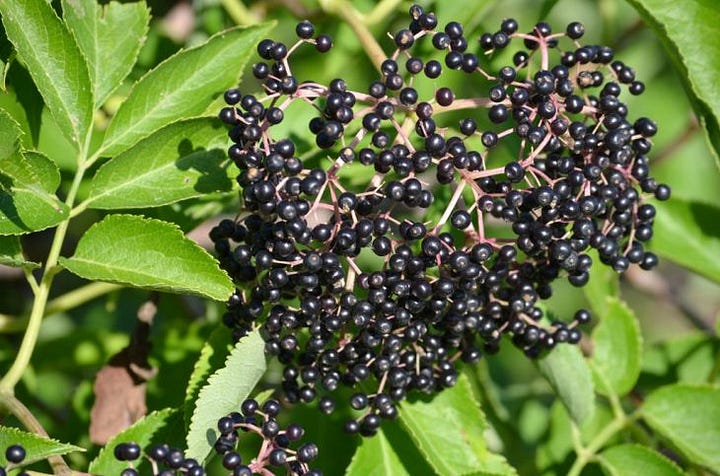
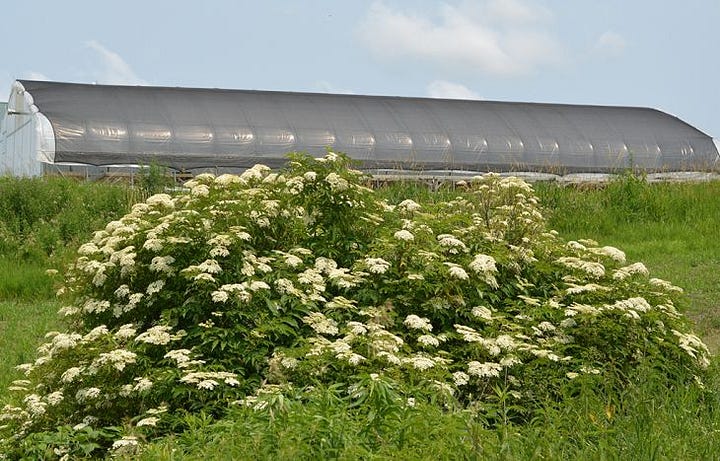
Native Range: Eastern North America and parts of South America.
Growth Habit: Elderberry is a multi-stemmed shrub that favors moist soils and full to partial sun. It can grow up to 13 feet tall over the course of a few seasons. It establishes in a garden or yard quickly, especially if it is given the best conditions.
Medicine: Elder flower and Elder berry are must haves for most medicine cabinets. Elder flower is part of a traditional diaphoretic formula: equal parts of mint, elderflower, and yarrow to open the pours and sweat out a fever. The berry is well known for its cold and flu fighting power, though its best avoided by people with autoimmune conditions. Though I fall into the latter category and generally avoid Elderberry these days, it’s still one of my favorite herbs to plant and grow.
Plant Elder where you need a quick privacy screen or hedge. It will be a gift to yourself and all the creatures who pass through your area.
Photos by Prairie Moon Nursery
Honorable mentions to:
American Persimmon (my favorite fruit of all time)
Red Osier Dogwood (great for weaving brilliant red wreathes)
Pussy Willow (the cutest)
Service Berry (especially this one. We are going to plant so many Service Berries at our next place!)
Take this email to the nursery and plant some of these shrubs!! Tell me if you do and feel free to add more native medicinal shrubs you love to the comments.
Love,
Geraldine
P.S. I know I’ve been sending you a lot of lists lately - I just had an inspiration and I had to go with it. I have one more medicinal horticultural top ten list for you next week that will conclude this series.




